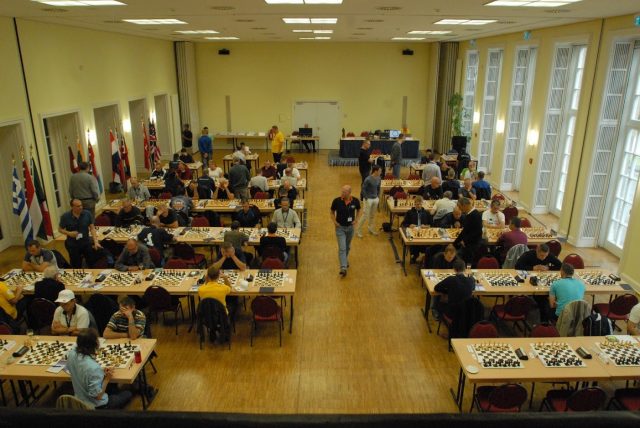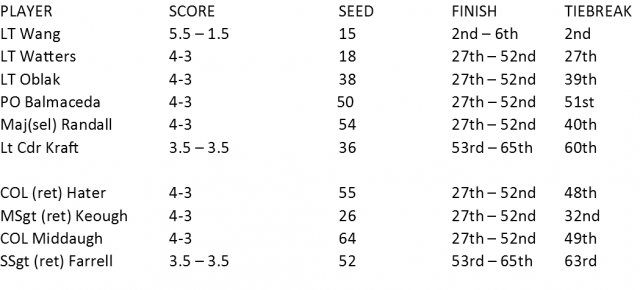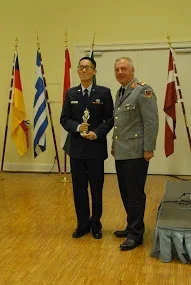Never (before this year!) in the history of the NATO Chess Championship has a U.S. player won an individual medal, and the U.S. has only taken team medals three times in the 30 year history of the event – Silver in 1989, Silver in 2002, and Bronze in 2014. The deck, if we are frank, is stacked against us.
The tournament is almost always in Europe so we have increased costs and time zones to deal with. There is no longer any funding from the United States Government. And the demographics of an all volunteer force, coupled with more than a decade of post 9/11 wars and deployments, make for significant challenges for the U.S..
This year we had some reasons for optimism. Our team was one of the strongest in our history, as we would be seeded 4th if this were a true team event. The tournament is an individual seven round swiss with teams of six from each country, and the top four scores determine the championship. There were three clear favorites: Germany, Poland, and Greece. Their squads all averaged over 2200 FIDE. There were six more teams that could be considered dark horses: the U.S., Italy, Denmark, Netherlands, and Slovenia. All had team ratings between 2034 and 2118 FIDE.
 2019 NATO Ch Playing Hall (photo David Hater)
All counted, there were 114 players representing 16 nations. The numbers of individuals is not exactly proportionate because teams are allowed to bring a team official and a team captain along, and there are a very few players who are lifetime members. These individuals may play in the event, but their scores may not count for their nation.
The U.S. team consisted of:
2019 NATO Ch Playing Hall (photo David Hater)
All counted, there were 114 players representing 16 nations. The numbers of individuals is not exactly proportionate because teams are allowed to bring a team official and a team captain along, and there are a very few players who are lifetime members. These individuals may play in the event, but their scores may not count for their nation.
The U.S. team consisted of:
 The rest of the U.S. delegation consisted of:
The rest of the U.S. delegation consisted of:
 Adding LT Wang to the team definitely gave us cause to be optimistic. It was clear to me from the outset that LT Wang was capable of winning the championship and he contended this year. His final undefeated score of 5.5 out of 7 was good enough to tie for second and take the Silver Medal on tiebreaks.
LT Wang provides annotations of a critical sixth round game against FM Fabrice Wantiez, the 1996 NATO Co-Champion.
Adding LT Wang to the team definitely gave us cause to be optimistic. It was clear to me from the outset that LT Wang was capable of winning the championship and he contended this year. His final undefeated score of 5.5 out of 7 was good enough to tie for second and take the Silver Medal on tiebreaks.
LT Wang provides annotations of a critical sixth round game against FM Fabrice Wantiez, the 1996 NATO Co-Champion.
 2019 U.S. NATO team
In spite of the fact that we did not win a medal, this year was very successful. All ten players had an even or plus score and many exceeded expectations based on pre-tournament rating. The final scores were:
2019 U.S. NATO team
In spite of the fact that we did not win a medal, this year was very successful. All ten players had an even or plus score and many exceeded expectations based on pre-tournament rating. The final scores were:
 There will be coverage of military chess, including this event, in the March issue of Chess Life. The team will be looking to build on its momentum when we travel to the 31st NATO Chess Championship in Brussels. If we continue the trend and score more points next year, we should finish in the medals.
If you are a military member or Department of Defense full time civilian employee, and you are interested in playing on the NATO team, please contact COL (ret) Hater at Click here to show email address.
There will be coverage of military chess, including this event, in the March issue of Chess Life. The team will be looking to build on its momentum when we travel to the 31st NATO Chess Championship in Brussels. If we continue the trend and score more points next year, we should finish in the medals.
If you are a military member or Department of Defense full time civilian employee, and you are interested in playing on the NATO team, please contact COL (ret) Hater at Click here to show email address.
 2019 NATO Ch Playing Hall (photo David Hater)
2019 NATO Ch Playing Hall (photo David Hater) The rest of the U.S. delegation consisted of:
The rest of the U.S. delegation consisted of:
 Adding LT Wang to the team definitely gave us cause to be optimistic. It was clear to me from the outset that LT Wang was capable of winning the championship and he contended this year. His final undefeated score of 5.5 out of 7 was good enough to tie for second and take the Silver Medal on tiebreaks.
LT Wang provides annotations of a critical sixth round game against FM Fabrice Wantiez, the 1996 NATO Co-Champion.
Adding LT Wang to the team definitely gave us cause to be optimistic. It was clear to me from the outset that LT Wang was capable of winning the championship and he contended this year. His final undefeated score of 5.5 out of 7 was good enough to tie for second and take the Silver Medal on tiebreaks.
LT Wang provides annotations of a critical sixth round game against FM Fabrice Wantiez, the 1996 NATO Co-Champion.
[pgn]
[Event "30th NATO Chess Championship"]
[Site "?"]
[Date "2019.09.19"]
[Round "6.2"]
[White "Wang, Eigen"]
[Black "Wantiez, Fabrice"]
[Result "1/2-1/2"]
[ECO "C45"]
[WhiteElo "2193"]
[BlackElo "2225"]
[Annotator "Wang"]
[PlyCount "71"]
1. e4 e5 2. Nf3 Nc6 3. d4 exd4 4. Nxd4 Bb4+ 5. c3 Bc5 {This is a variation of
the Scotch that I was not familiar with. I went with my instincts and tried to
control d5.} 6. Be3 Bb6 7. Nf5 Bxe3 8. Nxe3 d6 9. Bc4 Nf6 10. O-O O-O 11. Nd2
Re8 12. Bb3 Nxe4 $2 {Drastically changing the nature of the game. The open
structure after White gets the f7-pawn should be better for me because I gain
several tempo for my pieces to control the center.} 13. Nxe4 {This is a better
option than 13. Bxf7+, since after Kxf7 14. Nxe4 the knight on e4 is somewhat
vulnerable.} Rxe4 14. Bxf7+ Kh8 15. Qf3 {15. Bd5 is more accurate. The bishop
on d5 puts pressure on b7, restricting the knight on c6. This indirectly means
that White is more likely to maintain control of d5.} Re5 16. Bb3 Be6 17. Ng4
Bxb3 18. axb3 {At this point, I was happy with my pawn structure and the open
a-file. The plan going forward was ambiguous because of the lack of weaknesses
in Black's position and the limited number of pieces remaining on the board.}
Re7 19. b4 a6 20. Rfe1 {20. Ne3 was a better idea. Trading pieces helps Black
because of his cramped position. White should seize control of the center.} Qe8
21. Re3 Rxe3 22. Nxe3 Rb8 23. Nd5 Ne5 24. Qe4 c6 25. Ne3 d5 26. Qd4 Nd7 27. Re1
Nf6 28. Qf4 $5 {28. Qa7! I saw this idea during the game, but I underestimated
how powerful it was. One possible line is 28... Qc8 29. Nf5 Ra8 30. Nd6 Rxa7
31. Nxc8 Ra8 32. Nd6 b6 33. Re7 and White clearly has the better position.} Rd8
29. Kf1 Qe4 30. Qxe4 $6 {I considered 30. Qc7 and thought it would be risky to
leave the kingside deserted. In fact, this is fine for White. 30. Qc7! Rf8 31.
Qxb7 Qf4 (31... Qh4?? 32. Qxg7+!) 32. Kg1 and White defends successfully} Nxe4
31. f3 Nd6 32. Nc2 Rd7 33. Nd4 Kg8 34. Nb3 Kf7 35. Nc5 Rd8 36. h4 1/2-1/2
[/pgn]
On the team side, we contended for medals for the entire event and we scored more points than last year, but we were not quite able to finish in the medals. This year’s U.S. top 4 scored 17.5 points. That is more than last year when we scored 16 points and came in 4th. Our team ended up in 7th place, but 18 points was a tie for 4th through 6th. We had far better tiebreaks and would have finished 4th if we had half a point point more. We could have achieved that, but in the last round our top players went all out for wins in order to medal. They came up short and this allowed other teams to pass us.
Entering the last round, we had 16 points (already achieving the total from last year). We were only 1 point out of bronze medal. We estimated we needed wins to take over 3rd place, and two of our players were paired up. They played for the wins and had chances (which would have resulted in a U.S. medal), but we ultimately came up short.
 2019 U.S. NATO team
2019 U.S. NATO team There will be coverage of military chess, including this event, in the March issue of Chess Life. The team will be looking to build on its momentum when we travel to the 31st NATO Chess Championship in Brussels. If we continue the trend and score more points next year, we should finish in the medals.
If you are a military member or Department of Defense full time civilian employee, and you are interested in playing on the NATO team, please contact COL (ret) Hater at Click here to show email address.
There will be coverage of military chess, including this event, in the March issue of Chess Life. The team will be looking to build on its momentum when we travel to the 31st NATO Chess Championship in Brussels. If we continue the trend and score more points next year, we should finish in the medals.
If you are a military member or Department of Defense full time civilian employee, and you are interested in playing on the NATO team, please contact COL (ret) Hater at Click here to show email address.Categories
Archives
- January 2026 (2)
- December 2025 (27)
- November 2025 (29)
- October 2025 (39)
- September 2025 (27)
- August 2025 (29)
- July 2025 (43)
- June 2025 (25)
- May 2025 (24)
- April 2025 (29)
- March 2025 (29)
- February 2025 (20)
- January 2025 (24)
- December 2024 (34)
- November 2024 (18)
- October 2024 (35)
- September 2024 (23)
- August 2024 (27)
- July 2024 (44)
- June 2024 (27)
- May 2024 (31)
- April 2024 (51)
- March 2024 (34)
- February 2024 (25)
- January 2024 (26)
- December 2023 (29)
- November 2023 (26)
- October 2023 (37)
- September 2023 (27)
- August 2023 (37)
- July 2023 (47)
- June 2023 (33)
- May 2023 (37)
- April 2023 (45)
- March 2023 (37)
- February 2023 (28)
- January 2023 (31)
- December 2022 (23)
- November 2022 (32)
- October 2022 (31)
- September 2022 (19)
- August 2022 (39)
- July 2022 (32)
- June 2022 (35)
- May 2022 (21)
- April 2022 (31)
- March 2022 (33)
- February 2022 (21)
- January 2022 (27)
- December 2021 (36)
- November 2021 (34)
- October 2021 (25)
- September 2021 (25)
- August 2021 (41)
- July 2021 (36)
- June 2021 (29)
- May 2021 (29)
- April 2021 (31)
- March 2021 (33)
- February 2021 (28)
- January 2021 (29)
- December 2020 (38)
- November 2020 (40)
- October 2020 (41)
- September 2020 (35)
- August 2020 (38)
- July 2020 (36)
- June 2020 (46)
- May 2020 (42)
- April 2020 (37)
- March 2020 (60)
- February 2020 (38)
- January 2020 (45)
- December 2019 (34)
- November 2019 (35)
- October 2019 (42)
- September 2019 (45)
- August 2019 (56)
- July 2019 (44)
- June 2019 (35)
- May 2019 (40)
- April 2019 (48)
- March 2019 (61)
- February 2019 (39)
- January 2019 (30)
- December 2018 (29)
- November 2018 (51)
- October 2018 (45)
- September 2018 (29)
- August 2018 (49)
- July 2018 (35)
- June 2018 (31)
- May 2018 (39)
- April 2018 (31)
- March 2018 (26)
- February 2018 (33)
- January 2018 (30)
- December 2017 (26)
- November 2017 (24)
- October 2017 (30)
- September 2017 (30)
- August 2017 (31)
- July 2017 (28)
- June 2017 (32)
- May 2017 (26)
- April 2017 (37)
- March 2017 (28)
- February 2017 (30)
- January 2017 (27)
- December 2016 (29)
- November 2016 (24)
- October 2016 (32)
- September 2016 (31)
- August 2016 (27)
- July 2016 (24)
- June 2016 (26)
- May 2016 (19)
- April 2016 (30)
- March 2016 (36)
- February 2016 (28)
- January 2016 (32)
- December 2015 (26)
- November 2015 (23)
- October 2015 (16)
- September 2015 (28)
- August 2015 (28)
- July 2015 (6)
- June 2015 (1)
- May 2015 (2)
- April 2015 (1)
- February 2015 (3)
- January 2015 (1)
- December 2014 (1)
- July 2010 (1)
- October 1991 (1)
- August 1989 (1)
- January 1988 (1)
- December 1983 (1)









